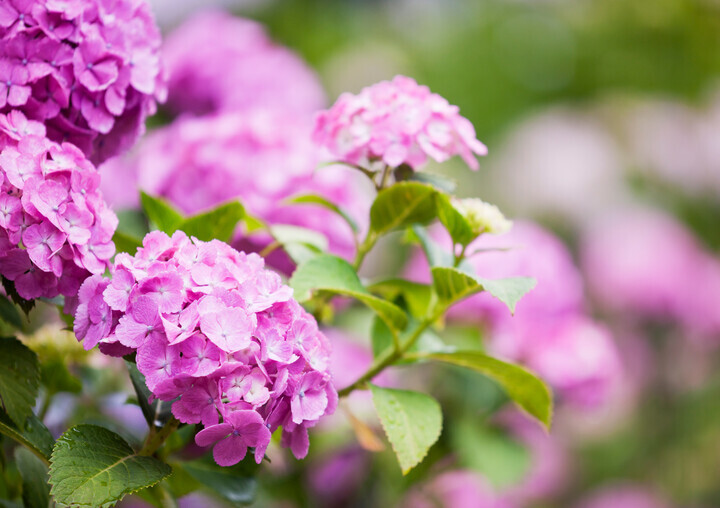Roll up your sleeves and get ready to dig a deep hole.

The time to plant a brand-new hydrangea is just around the corner: It might come as a surprise, but fall is the best time to plant these flowering shrubs. While it may not bloom during this season, you can look forward to lots of bright blooms come late spring. In fall, "the temperatures are usually more favorable" for new hydrangea plants, explains Ryan McEnaney, public relations and communications specialist for Bailey Nurseries. What's more, planting in fall gives "the plant time to establish a root system before the ground freezes, and then it's in place to give you a full season of color the following year."
Here, McEnaney takes us through the essential steps for planting a new hydrangea—and how to help it thrive both now and in the future.
Purchase a large enough shrub.
McEnaney says the ideal hydrangea will be a one- to two-gallon shrub. "The plant will be a bit heartier, have a bigger root system, and the strength to establish itself in your landscape," he explains. "If you have the stamina to dig a big hole, go for a three- or five-gallon plant so you have immediate impact." Of course, you may want to grow a hydrangea from seed, and that's a different process, says Chris Link, co-founder of Plant Addicts. To grow a hydrangea from seeds, fill a pot with soil and place the seeds on top of the dirt—not buried beneath it. Then, put your pot near a sunny window indoors, and keep the soil moist while the seeds germinate. (That should take about 14 days, Link says.) When you see shoots, you can plant your hydrangea outside following the steps below.
Find the right place to plant it.
"When you're ready to plant, be sure to select a location that has morning sun and dappled afternoon shade," instructs McEnaney. Hydrangea leaves can easily burn if exposed to too much sun. The perfect spot also has well-drained loam conditions—soil that is equal parts clay, silt, and sand. "This plant really likes well-drained soil that's rich in nutrients," McEnaney says. "So, if you've got heavy clay or sand, make sure that you're amending the soil for good drainage—using gypsum in clay—and enough water retention by adding peat moss in sand."
The perfect spot also has enough space for the hydrangea to spread its branches. Some hydrangeas bloom up to six-feet-wide. Be sure to check the plant's tag to see what its mature size will be before planting it. When planting hydrangea, "you want to ensure there is space for air flow," McEnaney explains. To do so, plant hydrangeas at least two feet apart. This allows air to circulate between the plants and helps prevent mildew.
Dig a big enough hole.
"When planting your hydrangea, dig the hole big enough to amend the soil as necessary and deep enough so that when you set the plant in the ground the soil level matches the top of the ground," McEnaney says. In other words, the soil that came from the pot in which you purchased the plant should be in line with the soil that it's going into. "Make sure not to plant too high or too low," he warns. "If it's planted too high, the top of the root ball can dry out. If it's planted too low, the stems can rot" and even kill the plant. Once you've dug the hole, "fill it back in with added nutrients, pack it in tightly around the base of the plant, and build a small mound to create a water dam," McEnaney says. (A water dam around the plant ensures the water won't run off and instead, will flow down to the plant's roots.)
Add a little fertilizer.
"Most hydrangeas that come from a garden center will have some fertilizer in the potting mix, but it's okay to add some granular, slow-release fertilizer for an extra kick of energy," says McEnaney. He recommends fertilizers that are "focused on bloom boosting, like Espoma's Flower-Tone fertilizer." After your plant has taken root, he recommends adding fertilizer just twice a year: Once in the early spring, and again in mid-summer to help the plant thrive in hot months. Whatever you do, don't over-fertilize your hydrangea: "Adding fertilizer weekly can add too much nitrogen to the soil, which can actually slow bloom production," McEnaney warns.
Water it well.
Your freshly-planted hydrangea will need a little more water than established plants, McEnaney says, which prefer well-drained soil. The first time you water it, allow the dam to fill and drain—then water it once more. After that, "the best rule of thumb is just to get your fingers a little dirty," McEnaney instructs. "Stick your finger in the soil past the first knuckle. If it's dry, give it a good soak. If it's moist or wet, leave it alone. Depending on your natural rainfall and summer temperatures, this could mean watering every day or two, or it could meal that you only have to water once a week. Just check the soil and it will tell you what it needs."